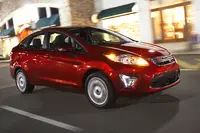2011 Ford Fiesta TACH Review - 35MPG and Zippy Too
Make Me Smarter Link: 2011 Ford Fiesta News - The Auto Channel News Library
Make Me Smarter Link: All Brand 30+ MPG 2011 Sedans Ranked by Price
Make Me marter Link: Ford Buyers Guide - 2011 Fiesta Specs, Prices and Comparisons
THE AUTO PAGE
By John Heilig
The Auto Channel
Engine: 1.6-liter I4
Horsepower/Torque: 120 hp @ 6,350 rpm/112 lb.-ft. @ 5,000 rpm
Transmission: 5-speed manual
Wheelbase: 98.0 in.
Length x Width x Height: 160.1 x 67.8 x 58.0 in.
Tires: P195/50R16
Cargo: 12.8 cu. ft. in sedan
Economy: 28 mpg city/37 mpg highway/35.0 mpg test
Fuel capacity: 12.0 gal.
Curb Weight: 2,537 lbs.
Sticker: $18,810 (includes $675 destination and delivery charge and $1,690 in options)
The Bottom Line: The most practical. Who needs hybrids when you can get 35 mpg from a small internal combustion engine that will probably last longer than the battery packs in your friendly hybrid? If this is a glimpse of the future of the American automobile in $5/gallon gasoline, then the future isn’t as dark as it may have originally seemed.
So we’re chugging along in the Ford Fiesta and I asked my wife to check the Monroney (MSRP STICKER) to see how big the engine is, etc. She told me it was a 1.6-liter four and I gasped in astonishment (well, not really, but astonishment is my word of the day). The little four-banger is as peppy as a larger engine and, when combined with the neat 5-speed manual transmission, it offers decent performance. Oh, it’s no 5-liter V8, but you can get around nicely in the four. You’ll also save some money, since the engine delivered 35 mpg in our test, which included mostly suburban driving with a minimum of Interstates.
Like most fours, the Fiesta’s engine is noisy on acceleration, but it’s relatively quiet under normal operation. And, like most small mills, you have to work with the transmission to extract the best performance.
We found the handling to be very good on our hillclimb course. There was some minor lean on the harder corners, but nothing that gave us visions of turning turtle.
The front seats are reasonably comfortable, with some side support. The rears have similar side support, but restricted leg room. Our granddaughters asked that we move the seats forward, or reduce the rake of the seat back, so they’d have room for their feet when they were in child seats. I sat back there once and agreed about the minimal leg room. It wasn’t impossible, but I wouldn’t want to sit back there for an extended period of time.
Behind those rear seats is a decent trunk under the hatchback. Ford’s Web site didn’t list the cargo capacity of the hatchback, but its 12.8 cubic feet in the Fiesta sedan. The rear seats fold flat to increase cargo capacity dramatically. While I liked the trunk, I had to lower one of the seats to fit my golf bag back there. I had some loose balls that ended up under the trunk floor, though.
For entertainment we had an AM/FM/CD/SAT/AUX. The satellite radio wasn’t hooked up and the FM couldn’t pull in my favorite Philly stations. And, for some reason, my iPod didn’t connect with the AUX/USB, so we drove around without entertainment. There was an audio output indicator on what would normally function as a navigation screen. In addition, the “smiley” audio controls on the center stack were confusing.
The HVAC system, however, was great, with only three knobs to control everything.
As far as styling is concerned, the Fiesta fits in well with the current generation of small cars, with some plusses and some minuses. There are small “wing window” windows on the sides over the dash. They help a little, but their main function is to eliminate the possibility of a solid panel there.
One of my favorite features, and one that I’ve seen in other Ford products, is the “blind spot” convex mirrors located at the top outer edge of the exterior rear view mirrors. These little mirrors help the driver to see if there are any cars or trucks in the left and right blind spots. It’s a very elegant solution to that problem, and probably a lot more reliable than the electronic monitors.
The Fiesta is a small car with a big heart and a lot of possibilities. For a family of two, or with young children, it could be ideal.
© 2011 The Auto Page, The Auto Channel, LLC



